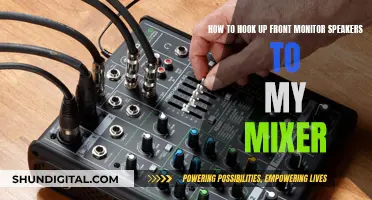
Ankle monitors, also known as ankle bracelets, ankle shackles, or tethers, are electronic monitoring devices used to track the location of individuals who are awaiting trial, on probation or parole, or facing immigration proceedings. They are typically used as an alternative to incarceration, allowing individuals to remain in their community instead of serving time in jail. While the use of ankle monitors has been justified as a way to decongest prisons, particularly during the COVID-19 pandemic, there are concerns about their effectiveness and impact on individuals' lives. Some people have been placed on ankle monitors for extended periods, even for years, and the devices have been criticised for restricting movement, limiting opportunities for education and employment, and exacerbating social stigma and isolation. The cost of renting ankle monitors, which is often passed on to the wearer, can also be a significant financial burden.
| Characteristics | Values |
|---|---|
| How long do ankle monitors stay on? | This depends on the case and the jurisdiction. In some cases, ankle monitors are used as an alternative to bail while the wearer awaits trial. In other cases, ankle monitors are used as a condition of parole. |
| Who wears ankle monitors? | People awaiting trial, serving probation and parole, and facing immigration proceedings. |
| Who decides how long ankle monitors stay on? | Judges, in conjunction with law enforcement departments and probation officers. |
| How do ankle monitors work? | Ankle monitors use Radio Frequency (RF) and Global Positioning System (GPS) technology to track the location of their wearers. |
| How often do ankle monitors need to be charged? | GPS ankle monitors need to be charged for 2 hours every day. |
| What happens if an ankle monitor is damaged? | Any damage to an ankle monitor must be immediately reported to the wearer's probation officer. If the damage is intentional, the wearer may be pursued through the courts for reparation. |
| Can you remove an ankle monitor without being caught? | All ankle monitor systems have a way to tell if the device has been tampered with. Removing the monitor without triggering an alert is extremely difficult, but not impossible. |
What You'll Learn

Who wears ankle monitors?
Ankle monitors are worn by people who have been sentenced by a court, are on probation or parole, or are awaiting trial. They are also used as an alternative to detention for those who are not considered a danger to society, such as troubled teens who have committed minor crimes like shoplifting, or drunk driving in the case of adults.
In the US, ankle monitors are also used to track the location of undocumented immigrants facing removal from the country. They are sometimes permitted to remain free until their hearing, on the condition that they wear an ankle monitor so that US Immigration and Customs Enforcement (ICE) can monitor their whereabouts.
Ankle monitors are also used as an alternative to jail for those charged with driving under the influence of alcohol or other substances. These monitors can be used to track alcohol consumption by testing the wearer's perspiration for the presence of alcohol.
In some cases, ankle monitors are used as a condition of house arrest, where the wearer is confined to their home or permitted to travel to certain locations outside the home, such as a place of employment or a treatment centre.
The cost of ankle monitors can vary, with some people being charged hundreds of dollars a month to wear them. This has led to criticisms that ankle monitors can drive people into debt and create financial burdens, especially for those who are already struggling financially.
Ankle Monitor Battery Life: How Long Does It Last?
You may want to see also

How do ankle monitors work?
Ankle monitors, also known as ankle bracelets or shackles, are electronic monitoring devices that use GPS tracking systems to record the location of the wearer. They are typically court-ordered for people who are awaiting trial, serving probation or parole, or facing immigration proceedings. The monitor is worn on the ankle 24 hours a day, 7 days a week, and it has a battery life of about 2-3 months. The wearer must charge the device for 2 hours every day, and it takes approximately 2 hours to fully charge a low battery.
The ankle monitor is connected to a monitoring unit placed at the wearer's home address. This unit creates an electronically monitored boundary, which the wearer must not cross without permission. If the wearer needs to leave the address in an emergency, they must contact their probation officer as soon as possible.
Ankle monitors are designed to be secure and difficult to remove without detection. They typically have a fibre optic cable that runs through the strap and connects to the main unit. If this cable is interrupted in any way, it triggers an alert, notifying the monitoring authorities. Additionally, the monitor vibrates when it is connected or disconnected from the charger, and when the battery is low.
While ankle monitors can provide information about the wearer's location and speed, they do not provide real-time information about the wearer's activities. For example, if the wearer is in a parking lot, the monitor can detect their location but not necessarily the reason for their presence there.
Black Spots on Monitors: Understanding the Cause and Solution
You may want to see also

What are the rules for wearing an ankle monitor?
Ankle monitors are typically used as an alternative to pre-trial detention or as a condition of probation. They are also used to ensure that a defendant appears in court on their scheduled trial date. If you are required to wear an ankle monitor, you will need to adhere to specific rules and regulations. Here are some general rules for wearing an ankle monitor:
- You must keep a job.
- You must stay in compliance with all conditions of supervision.
- You must pay all your court fees.
- You must meet with your probation or parole officer at scheduled times.
- You must abstain from drugs and alcohol.
- You must not attempt to remove or damage the device.
- You must remain within a certain radius of your home.
- You must regularly check in with your probation officer.
- You must refrain from contacting certain people.
- You must adhere to a curfew.
In addition to these general rules, there may be other specific conditions that you must follow, depending on your particular case. For example, if you are on house arrest, you may only be allowed to leave your home for specific purposes, such as going to work, the doctor, or religious services. If you are a DUI or DWI offender, you may be required to wear an ankle monitor that can detect your alcohol levels, ensuring you comply with court orders not to drink.
It is important to note that the consequences of breaking the rules while wearing an ankle monitor can be serious. You may be subject to arrest, face stricter monitoring terms, have your parole revoked, or even face additional jail time.
Asus Monitor Model: A Quick Identification Guide
You may want to see also

What happens if you break the rules?
Ankle monitors are often used as an alternative to jail time, allowing individuals to serve their sentences in the community. However, this privilege comes with a set of rules that must be strictly adhered to. So, what happens if you break the rules?
Firstly, it is important to understand the potential consequences of non-compliance. The consequences can vary depending on the severity of the violation and the specific conditions set by the court. In some cases, breaking the rules may result in stricter monitoring terms or additional penalties. For instance, if an individual violates the terms of their ankle monitor in Florida, they may be subject to jail time. Similarly, in Connecticut, violating the terms of your release, including the conditions set by the ankle monitor, could lead to jail time.
One of the most common rules associated with ankle monitors is the requirement to stay within a designated area or boundary. If an individual attempts to leave the specified area, the monitor will send an alert to the relevant authorities, who may then take appropriate action. In some cases, this could lead to law enforcement apprehension and potential jail time.
Another important rule is the prohibition against tampering with or attempting to remove the ankle monitor. These devices are designed with tamper-proof bands, and any attempt to remove or damage them will trigger an automatic signal to law enforcement agencies. For example, in Florida, the removal of a court-ordered GPS monitoring device is considered a third-degree felony.
Additionally, individuals with ankle monitors are typically required to regularly check in with their probation or parole officer and obtain approval for any necessary absences during their curfew. Failure to comply with these requirements may result in negative consequences, such as stricter monitoring terms or revocation of parole.
Furthermore, ankle monitors are often used in cases of domestic violence to ensure that the offender maintains a required distance from the victim. Violating this rule by attempting to contact or come near the victim could result in serious repercussions, including additional penalties or jail time.
In conclusion, breaking the rules while on an ankle monitor can have significant consequences. It is crucial for individuals to understand and abide by the conditions set by the court to avoid further legal repercussions and ensure a smooth transition back into society.
Diagnosing Lexus RX350 Blind Spot Monitor: Step-by-Step Guide
You may want to see also

How much do ankle monitors cost?
The cost of an ankle monitor varies depending on the state and the income of the defendant. In the US, the cost to install a monitor is usually between $50 to $100, with a daily monitoring fee on top of that. The daily fee can range from $5 to $40. In some states, defendants are required to pay the cost of the monitor themselves, which can amount to hundreds of dollars per month. In other cases, the court may pay for the system if the defendant is indigent.
In addition to the cost of the monitor itself, there are often other associated costs. For example, some states require a landline phone for their monitors, which can add an extra cost for the wearer. There may also be costs incurred if the tracking component of the device is lost or damaged.
The financial burden of ankle monitors can be significant, and for some people, it can lead to debt and unemployment. In some cases, people may choose to plead guilty and be placed on probation rather than pay for an ankle monitor, as it can be the cheaper option.
Monitor Bandwidth and Data Usage Like a Geek
You may want to see also
Frequently asked questions
Ankle monitors are typically worn 24 hours a day, 7 days a week. The duration of usage depends on the conditions of the sentence or order.
The Court or the New Zealand Parole Board decides whether electronic monitoring is included as part of a sentence or order.
Any damage to the ankle monitor must be immediately reported to the wearer's Probation Officer. Intentional damage may result in legal repercussions.
Ankle monitors with GPS tracking must be charged for 2 hours every day. The cordless charger allows wearers to move around while charging.
Violating the conditions of your ankle monitor, such as not charging the device or leaving your address without permission, may result in legal repercussions, including reincarceration.







